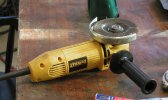Hello all,
I"m looking for a general idea of how much work can I expect to get from a good belt.
Where I live, there are VERY few bladesmiths, and grinder belts (72X2) are VERY hard to get. So I can"t realy "check around". I want to determain if the brand I do get, is "good". Or do I need to make a (big) effort and risk a change.
I guess it's difficult to give such a measure. Say you need to thin a whole cheff knife (not hardened) by 1mm (1/16"), using rough belt. no polishing. How many belts do you need? (0.5 is a valid answer).
Any other measurment is welcome.
Thanks,
I"m looking for a general idea of how much work can I expect to get from a good belt.
Where I live, there are VERY few bladesmiths, and grinder belts (72X2) are VERY hard to get. So I can"t realy "check around". I want to determain if the brand I do get, is "good". Or do I need to make a (big) effort and risk a change.
I guess it's difficult to give such a measure. Say you need to thin a whole cheff knife (not hardened) by 1mm (1/16"), using rough belt. no polishing. How many belts do you need? (0.5 is a valid answer).
Any other measurment is welcome.
Thanks,

